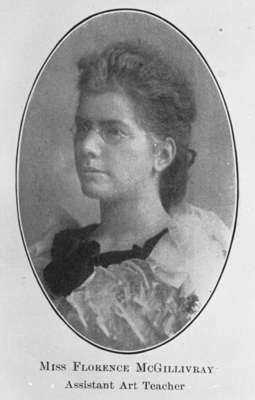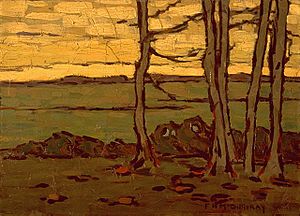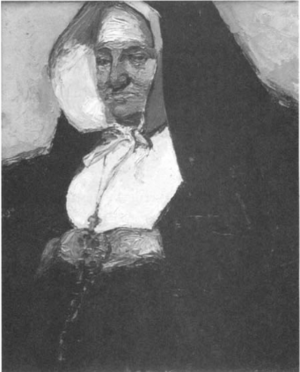Florence Helena McGillivray facts for kids
Quick facts for kids
Florence Helena McGillivray
|
|
|---|---|

Florence H. McGillivray, 1937
|
|
| Born | March 1, 1864 Township of Pickering, Ontario, Canada
|
| Died | May 7, 1938 (aged 74) Toronto, Ontario, Canada
|
| Education | Central Ontario School of Art, Académie de la Grande Chaumière |
| Known for | Painter, teacher |
Florence Helena McGillivray (born March 1, 1864 – died May 7, 1938) was a talented Canadian artist. People also knew her as F. H. McGillivray. She was famous for her landscape paintings, especially her unique Post-Impressionist style. Florence lived in Whitby, Ontario, and later in Ottawa from 1914 to 1928. Besides painting, she was also a teacher. She even encouraged another famous Canadian painter, Tom Thomson, in 1916.
Contents
Early Life and Learning to Paint
Florence McGillivray was born in Pickering Township, Ontario, on March 1, 1864. She was one of thirteen children in her family. Her parents were George and Caroline McGillivray.
In 1870, her family moved to a house called Inverlynn in Whitby, Ontario. This house is still owned by her family today. Florence showed artistic talent from a young age. She went to the Central Ontario School of Art in Toronto. This school is now known as Ontario College of Art. There, she studied with a teacher named William Cruikshank. Florence also took private lessons from other artists like Farquhar McGillivray Knowles and Lucius Richard O'Brien.
In the 1890s, Florence became known for painting on china. From 1892 to 1905, she taught art at Pickering College, a school for boys. Later, from 1906 to 1923, she was an art teacher at the Ontario Ladies’ College in Whitby, now called Trafalgar Castle School.
In 1912, Florence traveled to France to study art. She attended the Académie de la Grande Chaumière in Paris. While there, she was greatly inspired by the artist Frédéric Fiebig. She started to use a palette knife to apply paint more thickly. This gave her paintings a special texture. That same year, she showed her new artwork at the famous Salon des Beaux Arts in Paris.
Her Art Career
In 1913, Florence McGillivray's painting Contentment was shown at the Salon des Beaux Arts in Paris. She moved back to Canada in 1914 because World War I had started.
The 1920s were a very important time for her art. She lived in Ottawa and had her own studio. Her paintings from this period are full of bright colors and interesting textures. They show the Post-Impressionist style she learned in Europe. She used thick paint and strong lines, which made her work unique in Canada. Even Tom Thomson admired her art, saying she was "one of the best."
Florence McGillivray was one of the first women artists to paint the landscapes of northern Ontario and Quebec. She painted many places, including the Gatineau River, the Ottawa River, and scenes from Europe, Bermuda, Jamaica, and the Bahamas. Her work helped connect older styles of Canadian landscape painting with the new ideas of the Group of Seven artists.
Art Shows and Collections
Florence McGillivray's paintings were shown in many exhibitions:
- 1913: Her painting Contentment was shown at the Salon des Beaux Arts in Paris.
- 1914-1935: She exhibited with the Royal Canadian Academy of Arts.
- 1917-1938: She exhibited with the Ontario Society of Artists.
- 1924: Her work was part of the British Empire Exhibition in England.
- 1927: Her art was shown in Paris at the Exposition d’art canadien.
- 1928: She had her own show at the Art Association of Montreal.
- Later, there were special shows of her work, including a retrospective in Whitby in 1970 and Finding Florence in 2017.
Her paintings are kept in many public art collections. Three of her works are at the National Gallery of Canada: Midwinter, Dunbarton, Ontario (1918), Afterglow (1914), and St. Anthony Harbour, Newfoundland (1926). Other galleries, like the Art Gallery of Ontario and the Art Gallery of Hamilton, also have her art.
Art Groups and Associations
Florence Helena McGillivray was part of many art groups during her life.
- She joined the Women's Art Association of Canada. Here, she studied painting on china with Mary Dignam.
- She also became a member of groups like the Society of Women Painters and Sculptors of New York.
- In 1898, she continued her china painting studies in New York. She later sold her pieces from her studio in Whitby and taught painting classes there.
As she got older, she joined more important art groups:
- She became a member of the Ontario Society of Artists in 1917.
- In 1924, she became an Associate member of the Royal Canadian Academy of Arts.
- In 1925, she was a founding member of the Canadian Society of Painters in Water Colour. She was also the first woman to join this group.
Later Years
Florence McGillivray traveled a lot to find new landscapes to paint. In 1930, when she was in her mid-60s, she bought a house in Toronto and retired. She continued to paint using the sketches she had collected from her travels around the world.
In 1937, another artist named Marion Long painted her portrait. This portrait is now at the Art Gallery of Ontario. Florence McGillivray never married and did not have children. She passed away in Toronto on May 7, 1938, at the age of 74. She is buried in Oshawa's Union Cemetery.
See also
- In Spanish: Florence Helena McGillivray para niños






